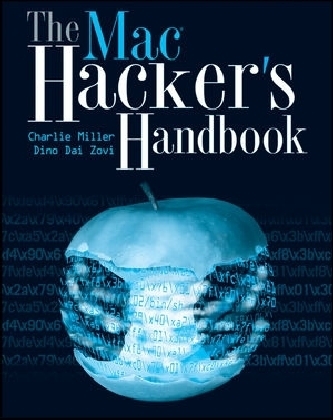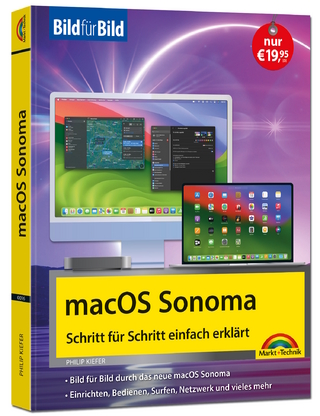
The Mac Hacker′s Handbook
John Wiley & Sons Ltd (Verlag)
978-0-470-39536-3 (ISBN)
- Titel ist leider vergriffen;
keine Neuauflage - Artikel merken
CharlIe Millerwon the second CanSecWest Pwn2Own contest in 2008 and was named one of the Top 10 Computer Hackers of 2008 by Popular Mechanics. Dino Dai Zovi won the first CanSecWest Pwn2Own contest in 2007 and was named one of the 15 Most Influential People in Security by eWEEK.
Foreword. Introduction. Part I Mac OS X Basics. Chapter 1 Mac OS X Architecture. Basics. XNU. Mach. BSD. I/O Kit. Darwin and Friends. Tools of the Trade. Ktrace/DTrace. Objective-C. Universal Binaries and the Mach-O File Format. Universal Binaries. Mach-O File Format. Example. Bundles. launchd. Leopard Security. Library Randomization. Executable Heap. Stack Protection (propolice). Firewall. Sandboxing (Seatbelt). References. Chapter 2 Mac OS X Parlance. Bonjour!. Get an IP Address. Set Up Name Translation. Service Discovery. Bonjour. mDNSResponder. Source Code. QuickTime. .mov. RTSP. Conclusion. References. Chapter 3 Attack Surface. Searching the Server Side. Nonstandard Listening Processes. Cutting into the Client Side. Safari. All of Safari's Children. Safe File Types. Having Your Cake. Conclusion . References. Part II Discovering Vulnerabilities. Chapter 4 Tracing and Debugging. Pathetic ptrace. Good Ol' GDB. DTrace. D Programming Language. Describing Probes. Example: Using Dtrace. Example: Using ltrace. Example: Instruction Tracer/Code-Coverage Monitor. Example: Memory Tracer. PyDbg. PyDbg Basics. Memory Searching. In-Memory Fuzzing. Binary Code Coverage with Pai Mei. iTunes Hates You. Conclusion. References. Chapter 5 Finding Bugs. Bug-Hunting Strategies. Old-School Source-Code Analysis. Getting to the Source. Code Coverage. CanSecWest 2008 Bug. vi + Changelog = Leopard 0-day. Apple's Prerelease-Vulnerability Collection. Fuzz Fun. Network Fuzzing. File Fuzzing. Conclusion. References. Chapter 6 Reverse Engineering. Disassembly Oddities. EIP-Relative Data Addressing. Messed-Up Jump Tables. Identifying Missed Functions. Reversing Obj-C. Cleaning Up Obj-C. Shedding Light on objc-msgSend Calls. Case Study. Patching Binaries. Conclusion. References. Part III Exploitation. Chapter 7 Exploiting Stack Overflows. Stack Basics. Stack Usage on PowerPC. Stack Usage on x86. Smashing the Stack on PowerPC. Smashing the Stack on x86. Exploiting the x86 Nonexecutable Stack. Return into system(). Executing the Payload from the Heap. Finding Useful Instruction Sequences. PowerPC. x86. Conclusion. References. Chapter 8 Exploiting Heap Overflows. The Heap. The Scalable Zone Allocator. Regions. Freeing and Allocating Memory. Overwriting Heap Metadata. Arbitrary 4-Byte Overwrite. Large Arbitrary Memory Overwrite. Obtaining Code Execution. Taming the Heap with Feng Shui. Fill 'Er Up. Feng Shui. WebKit's JavaScript. Case Study. Feng Shui Example. Heap Spray. References. Chapter 9 Exploit Payloads. Mac OS X Exploit Payload Development. Restoring Privileges. Forking a New Process. Executing a Shell. Encoders and Decoders. Staged Payload Execution. Payload Components. PowerPC Exploit Payload. execve-binsh. system. decode-longxor. tcp-listen 231. tcp-connect. tcp-find. dup2-std-fds. vfork. Testing Simple Components. Putting Together Simple Payloads. Intel x86 Exploit Payloads. remote-execution-loop. inject-bundle. Testing Complex Components. Conclusion. References. Chapter 10 Real-World Exploits. QuickTime RTSP Content-Type Header Overflow. Triggering the Vulnerability. Exploitation on PowerPC. Exploitation on x86. mDNSResponder UPnP Location Header Overflow. Triggering the Vulnerability. Exploiting the Vulnerability. Exploiting on PowerPC. QuickTime QTJava toQTPointer() Memory Access. Exploiting toQTPointer(). Obtaining Code Execution. Conclusion. References. Part IV Post-Exploitation. Chapter 11 Injecting, Hooking, and Swizzling. Introduction to Mach. Mach Abstractions. Mach Security Model Mach Exceptions. Mach Injection. Remote Threads. Remote Process Memory. Loading a Dynamic Library or Bundle. Inject-Bundle Usage. Example: iSight Photo Capture. Function Hooking. Example: SSLSpy. Objective-C Method Swizzling. Example: iChat Spy. Conclusion. References. Chapter 12 Rootkits. Kernel Extensions. Hello Kernel. System Calls. Hiding Files. Hiding the Rootkit. Maintaining Access across Reboots. Controlling the Rootkit. Creating the RPC Server. Injecting Kernel RPC Servers. Calling the Kernel RPC Server. Remote Access. Hardware-Virtualization Rootkits. Hyperjacking. Rootkit Hypervisor. Conclusion. References. Index.
| Verlagsort | Chichester |
|---|---|
| Sprache | englisch |
| Maße | 189 x 232 mm |
| Gewicht | 612 g |
| Themenwelt | Informatik ► Betriebssysteme / Server ► Macintosh / Mac OS X |
| Informatik ► Netzwerke ► Sicherheit / Firewall | |
| ISBN-10 | 0-470-39536-2 / 0470395362 |
| ISBN-13 | 978-0-470-39536-3 / 9780470395363 |
| Zustand | Neuware |
| Haben Sie eine Frage zum Produkt? |
aus dem Bereich


